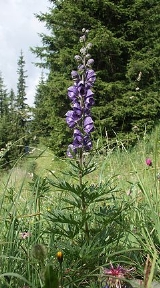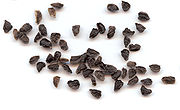
Aconitum napellus
Encyclopedia
Aconitum napellus is a species of Aconitum
in the family Ranunculaceae
, native and endemic
to western and central Europe
.
It is a herbaceous
perennial plant
growing to 1 m tall, with hairless stems and leaves. The leaves
are rounded, 5–10 cm diameter, palmately divided into five to seven deeply lobed segments. The flower
s are dark purple to bluish-purple, narrow oblong helmet-shaped, 1–2 cm tall.
 Nine subspecies
Nine subspecies
are accepted by the Flora Europaea:
Plants native to Asia and North America formerly listed as A. napellus are now regarded as separate species.
Plants are grown in gardens in temperate zones for their spike-like inflorescences that are showy in early-mid summer and their attractive foliage. There are white and rose colored forms in cultivation too.
used for fresh cutting material and sometimes used as dried material. The species has a low natural propagation rate under cultivation and is propagated by seed
or by removing offsets that are generated each year from the rootstocks. The use of micropropagation
protocols has been studied. This species has been crossed with other Aconitums to produce attractive hybrids for garden use, including Aconitum x cammarum
 Like other species in the genus, A. napellus contains several poison
Like other species in the genus, A. napellus contains several poison
ous compounds, including enough cardiac poison that it was used on spears and arrows for hunting and battle in ancient times. A. napellus has a long history of use as a poison, with cases going back thousands of years. During the ancient Roman period of European history the plant was often used to eliminate criminals and enemies, and by the end of the period it was banned and any one growing A. napellus could have been legally sentenced to death. Aconites have been used more recently in murder plots; they contain the Chemical alkaloids aconitine
, mesaconitine, hypaconitine and jesaconitine, which are highly toxic.
Aconite
produced from the roots of a number of different species of Aconitum is used ethnomedically in traditional Chinese medicine
(TCM), to treat "coldness", general debility, and "Yang deficiency". Misuse of the medicinal ingredients contained in this plant can negatively affect the cardiovascular and central nervous systems, thus resulting in death.
Aconitum
Aconitum , known as aconite, monkshood, wolfsbane, leopard's bane, women's bane, Devil's helmet or blue rocket, is a genus of over 250 species of flowering plants belonging to the buttercup family .-Overview:These herbaceous perennial plants are chiefly natives of the mountainous parts of the...
in the family Ranunculaceae
Ranunculaceae
Ranunculaceae are a family of about 1700 species of flowering plants in about 60 genera, distributed worldwide....
, native and endemic
Endemic (ecology)
Endemism is the ecological state of being unique to a defined geographic location, such as an island, nation or other defined zone, or habitat type; organisms that are indigenous to a place are not endemic to it if they are also found elsewhere. For example, all species of lemur are endemic to the...
to western and central Europe
Europe
Europe is, by convention, one of the world's seven continents. Comprising the westernmost peninsula of Eurasia, Europe is generally 'divided' from Asia to its east by the watershed divides of the Ural and Caucasus Mountains, the Ural River, the Caspian and Black Seas, and the waterways connecting...
.
It is a herbaceous
Herbaceous
A herbaceous plant is a plant that has leaves and stems that die down at the end of the growing season to the soil level. They have no persistent woody stem above ground...
perennial plant
Perennial plant
A perennial plant or simply perennial is a plant that lives for more than two years. The term is often used to differentiate a plant from shorter lived annuals and biennials. The term is sometimes misused by commercial gardeners or horticulturalists to describe only herbaceous perennials...
growing to 1 m tall, with hairless stems and leaves. The leaves
Leaf
A leaf is an organ of a vascular plant, as defined in botanical terms, and in particular in plant morphology. Foliage is a mass noun that refers to leaves as a feature of plants....
are rounded, 5–10 cm diameter, palmately divided into five to seven deeply lobed segments. The flower
Flower
A flower, sometimes known as a bloom or blossom, is the reproductive structure found in flowering plants . The biological function of a flower is to effect reproduction, usually by providing a mechanism for the union of sperm with eggs...
s are dark purple to bluish-purple, narrow oblong helmet-shaped, 1–2 cm tall.

Subspecies
Subspecies in biological classification, is either a taxonomic rank subordinate to species, ora taxonomic unit in that rank . A subspecies cannot be recognized in isolation: a species will either be recognized as having no subspecies at all or two or more, never just one...
are accepted by the Flora Europaea:
- Aconitum napellus subsp. napellus. Southwest England.
- Aconitum napellus subsp. corsicum (Gáyer) W.Seitz. Corsica.
- Aconitum napellus subsp. firmum (Rchb.) Gáyer. Central and eastern Europe.
- Aconitum napellus subsp. fissurae (Nyár.) W.Seitz. Balkans to southwest Russia.
- Aconitum napellus subsp. hians (Rchb.) Gáyer. Central Europe.
- Aconitum napellus subsp. lusitanicum Rouy. Southwest Europe.
- Aconitum napellus subsp. superbum (Fritsch) W.Seitz. Western Balkans.
- Aconitum napellus subsp. tauricum (Wulfen) Gáyer. Eastern Alps, southern Carpathians.
- Aconitum napellus subsp. vulgare (DC.) Rouy & Foucaud. Alps, Pyrenees, northern Spain.
Plants native to Asia and North America formerly listed as A. napellus are now regarded as separate species.
Plants are grown in gardens in temperate zones for their spike-like inflorescences that are showy in early-mid summer and their attractive foliage. There are white and rose colored forms in cultivation too.
Uses
Aconitum napellus is grown in gardens for its attractive spike like inflorescences and showy blue flowers. It is a cut flower cropCrop
Crop may refer to:* Crop, a plant grown and harvested for agricultural use* Crop , part of the alimentary tract of some animals* Crop , a modified whip used in horseback riding or disciplining humans...
used for fresh cutting material and sometimes used as dried material. The species has a low natural propagation rate under cultivation and is propagated by seed
Seed
A seed is a small embryonic plant enclosed in a covering called the seed coat, usually with some stored food. It is the product of the ripened ovule of gymnosperm and angiosperm plants which occurs after fertilization and some growth within the mother plant...
or by removing offsets that are generated each year from the rootstocks. The use of micropropagation
Micropropagation
Micropropagation is the practice of rapidly multiplying stock plant material to produce a large number of progeny plants, using modern plant tissue culture methods....
protocols has been studied. This species has been crossed with other Aconitums to produce attractive hybrids for garden use, including Aconitum x cammarum

Poison
In the context of biology, poisons are substances that can cause disturbances to organisms, usually by chemical reaction or other activity on the molecular scale, when a sufficient quantity is absorbed by an organism....
ous compounds, including enough cardiac poison that it was used on spears and arrows for hunting and battle in ancient times. A. napellus has a long history of use as a poison, with cases going back thousands of years. During the ancient Roman period of European history the plant was often used to eliminate criminals and enemies, and by the end of the period it was banned and any one growing A. napellus could have been legally sentenced to death. Aconites have been used more recently in murder plots; they contain the Chemical alkaloids aconitine
Aconitine
Aconitine is a highly poisonous alkaloid derived from various aconite species.-Uses:...
, mesaconitine, hypaconitine and jesaconitine, which are highly toxic.
Aconite
Aconite
Aconite may refer to:*Aconitum, a plant genus containing the monkshoods*Aconitine, "the queen of poisons", a toxin derived from some of the Aconitum genus plants*Winter aconite, a plant in the genus Eranthis...
produced from the roots of a number of different species of Aconitum is used ethnomedically in traditional Chinese medicine
Traditional Chinese medicine
Traditional Chinese Medicine refers to a broad range of medicine practices sharing common theoretical concepts which have been developed in China and are based on a tradition of more than 2,000 years, including various forms of herbal medicine, acupuncture, massage , exercise , and dietary therapy...
(TCM), to treat "coldness", general debility, and "Yang deficiency". Misuse of the medicinal ingredients contained in this plant can negatively affect the cardiovascular and central nervous systems, thus resulting in death.
External links
- Aconite, Aconitum napellus - Resource for aconitum napellus seed & information

